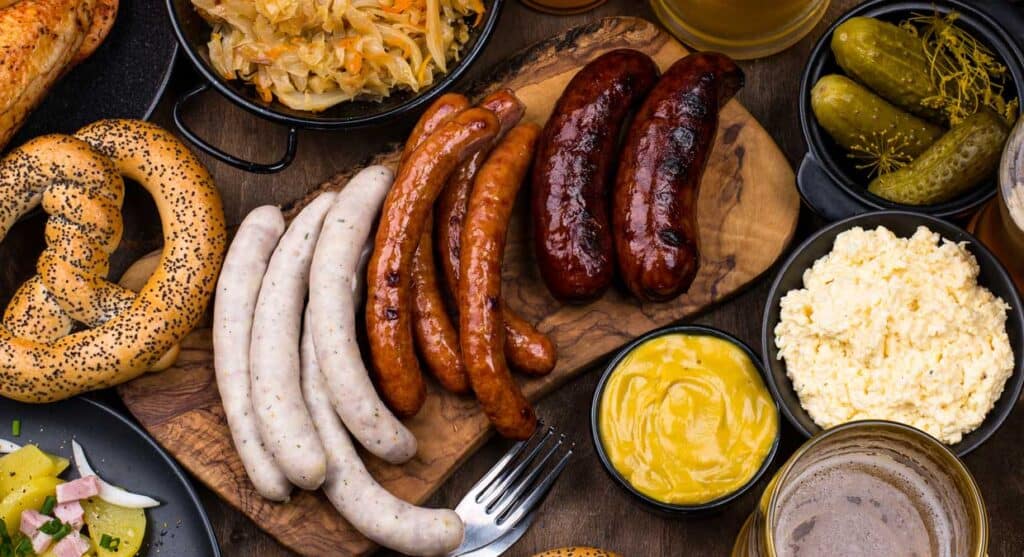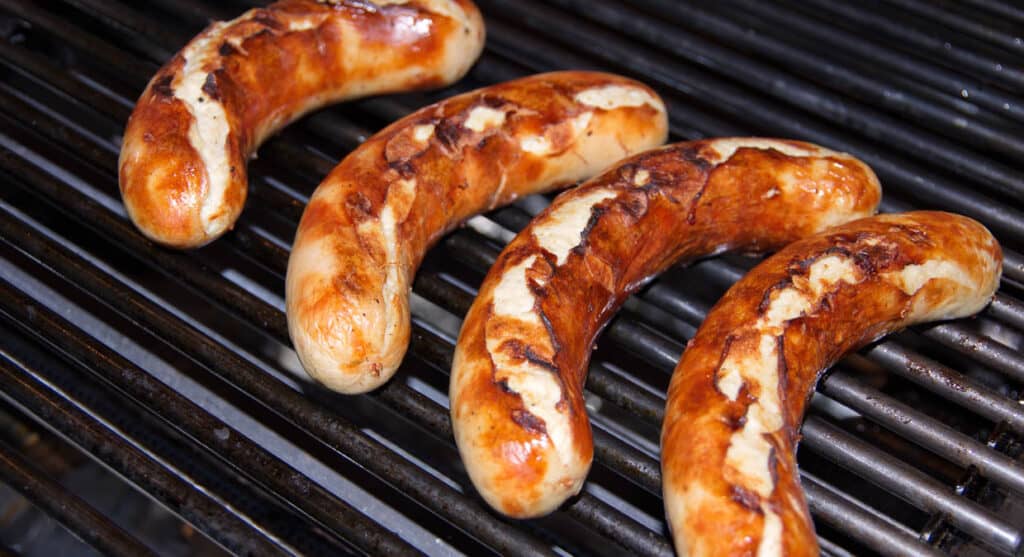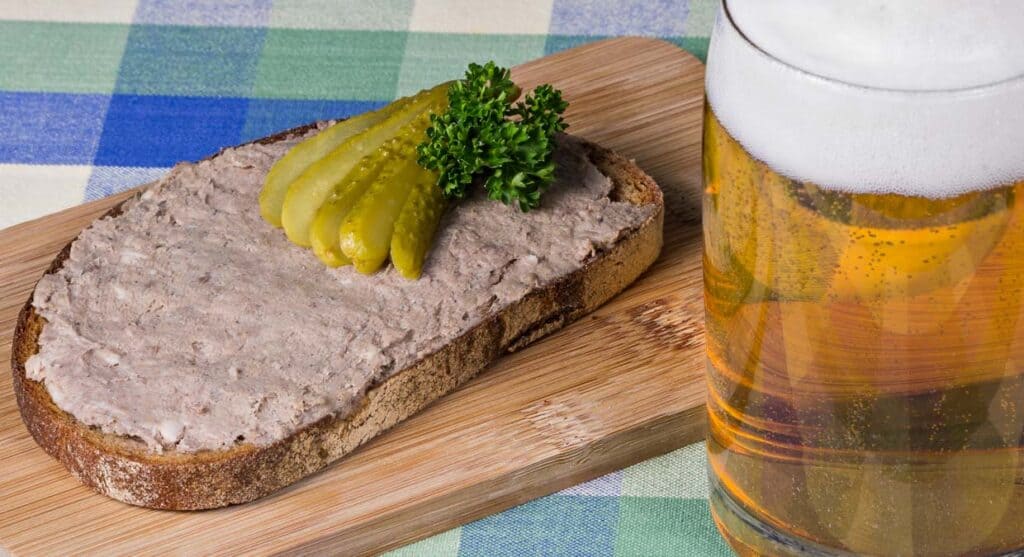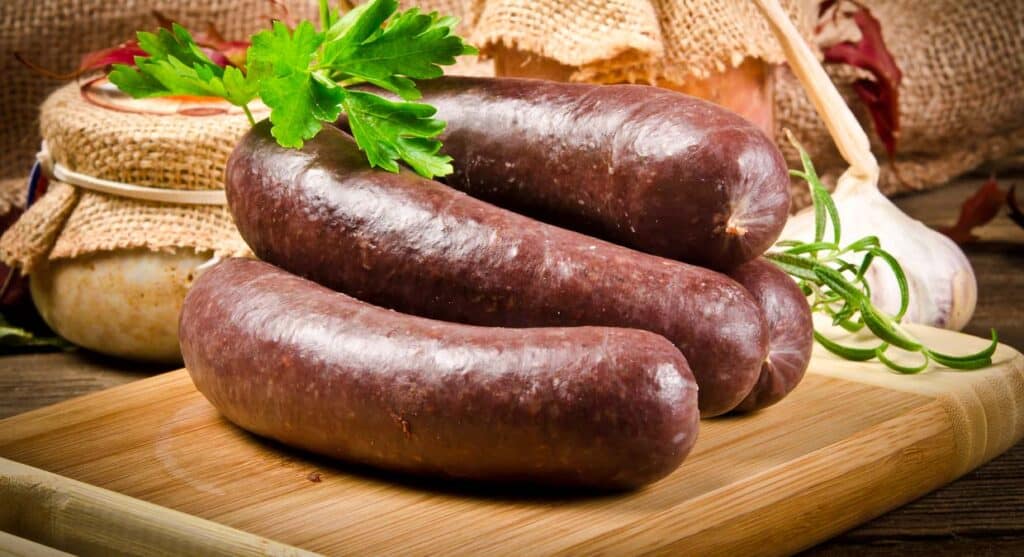German sausages are a culinary delight known and loved around the world that showcase the rich diversity of German cuisine. Types of German sausage go far beyond the ever-popular bratwurst and include many lesser-known varieties.

Whether grilled, pan-fried or boiled, they pack a punch of flavor, standing as a testament to the artistry of sausage making. So spice up your summer grilling and let’s explore some of the many sausages that have made Germany famous.
How many types of German sausage are there?
Germany prides itself on its love of sausages, creating hundreds of varieties distinguished by region, ingredients, preparation method and seasonings. Estimates suggest that well over 1000 different types of sausages exist in Germany.
Regional variations
The large number of sausages comes partly from regional variations. The bratwurst, probably the most well-known German sausage in the U.S., consists of finely chopped pork, veal or beef. However, in Germany, there are over 40 regional varieties of bratwurst.
For example, the recipe for thüringer rostbratwurst, which dates back to the 1400s, is spiced with marjoram, caraway and garlic. Fränkische bratwurst, on the other hand, uses a blend of marjoram, nutmeg and white pepper, while holsteiner bratwurst uses onions as its spice. So, in Germany, just bratwurst doesn’t exist. Everything depends on the region.
Influence on global cuisine
German sausages’ influence has spread far beyond Germany’s borders. The classic American hot dog derives from the frankfurter and Poland’s famous kielbasa shares its roots with sausages brought by German immigrants. In Brazil, a sausage known as linguiça reflects the country’s strong German heritage, especially in the southern regions.

Preparing German sausages
The best way to prepare the sausages varies, depending on the type and the regional traditions. Here are the most common methods.
- Grilling: Particularly popular for varieties of bratwurst, this method involves lightly scoring the sausages on the surface and grilling over charcoal or wood fire.
- Boiling: Some sausages, like Frankfurter and Weisswurst, are traditionally boiled since the heat from grilling or frying could cause the link to burst out of its delicate casing.
- Pan-Frying: This method works well for most types of sausage and is typical for dishes that incorporate sausages.
- Smoking: Smoking is most often a part of the sausage-making process rather than a cooking method, but it deserves mention because it adds a distinctive flavor.
But don’t feel tied to the traditional preparation methods. There is no reason you can’t decide to make German sausages in your air fryer or slow cooker, even though it isn’t traditional.

Types of German sausages
Now, let’s explore a few of the most popular types of German sausages available for your enjoyment.
Frankfurter würstchen
The frankfurter, a cousin to the American hot dog, is made from smoked and cooked pork. Their long, thin shape and smoky flavor instantly stand out. And as their name suggests, they hail from Frankfurt, Germany.
Knockwurst
Also known as Knackwurst, Knockwurst derives from finely ground, pre-cooked meat mixed with spices and garlic. When you bite into the sausage, its tight casing produces an audible “knack” sound, hence the name.
Leberwurst
Leberwurst, or liverwurst, is a versatile, spreadable sausage made from pork liver, onions and spices. Often, it’s served uncooked on bread or crackers as a quick sandwich or snack.
Blutwurst
Blutwurst, or blood sausage, may not cater to everyone’s tastes, but it appeals to the adventurous. The blend of pork blood, pork fat and fillers like barley gives this sausage a unique texture and earthy flavor. You’ll typically find it sliced, fried or as part of traditional German dishes.

Weisswurst
Weisswurst, or white sausage, comes from Bavaria. This traditional sausage gets its flavor from a mix of veal, back bacon, parsley, lemon and cardamom. Since these sausages aren’t smoked, in Germany, they’re usually made in the morning and consumed before lunch, typically served with mustard and soft pretzels.
“When we can get our hands on them, we love to grill weisswurst sausages. They are made from minced veal and pork back bacon and are delicious when paired with sweet mustard.”
— Sara Nelson, Real Balanced
Filled with appetizers, salads, sides, mains and desserts, Food Drink Life's cookbook will become your favorite!
- Easy and delicious recipes from a variety of top chefs and recipe developers.
- Bright, colorful pictures on every page.
- Printer-friendly recipes that you can download instantly to your device.
- Printable shopping list and a kitchen conversion sheet.
Leberkäse
Leberkäse, a versatile sausage, can be served hot or cold. A blend of finely ground corned beef, pork and bacon give it a meatloaf-like appearance, perfect for slicing onto a sandwich or into a casserole dish.
Bockwurst
Bockwurst, made from finely ground veal and pork, is named after the German beer Bock. Its mild flavor pairs exceptionally well with beer; you’ll frequently find it served with potato salad or soup.
Teewurst
Teewurst is spreadable, smoked raw sausage made from a blend of pork or beef and bacon. Its creamy consistency and high-fat content make it easy to spread. It’s often found on breakfast or charcuterie boards, served on bread or crackers.
Gelbwurst
Gelbwurst, or yellow sausage, is a mild, pale-colored sausage made from a mix of pork, veal and spices. The name comes from the yellow casing it’s traditionally stuffed into. It’s perfect as a cold cut in sandwiches or as a snack.
Mettwurst
Mettwurst, an intensely flavored, heavily smoked raw sausage, comes from a blend of pork and beef. You’ll find it both as a spreadable sausage and as firm sausage links that you can slice and enjoy with bread or crackers.
Currywurst
Currywurst isn’t a sausage but a trendy street food in Germany that sounds like it should be a sausage. It’s made from sliced pork or beef sausages smothered in a flavorful curry ketchup sauce. Serve it with fries or over rolls.

Where to find authentic German sausages
To find authentic German sausages, check out local restaurants and delis. Many cities and towns host German delis or restaurants specializing in traditional German cuisine.
Here, you can savor delicious sausages like bratwurst, weisswurst and knackwurst. Feel free to ask for recommendations; the staff is usually eager to help guide you through their offerings.
So this summer, step beyond beer brats and introduce some new and different German sausages to your backyard BBQ. And remember, authentic German sausages taste best when paired with traditional sides like sauerkraut, German mustard, potatoes, soft pretzels and beer.
Anne Jolly is the creator of the food blog Upstate Ramblings. She loves to cook with gadgets like an air fryer, sous vide or pressure cooker. In her free time she enjoys hiking, reading, knitting and spending time with her three kids.

Currywurst is a bratwurst cut up drizzle in Currey sauce and sprinkled with a mild curry powder. Not German in origin British troops start it off while stationed in Berlin.
Weisswurst is normally boiled in Bavaria and served with wine sauerkraut not grilled.
Leberkase grilled with a fried egg on top is normally the way my German wife served it up.
Great tips! I love the idea of topping my leberkase with a fried egg, that sounds very tasty.